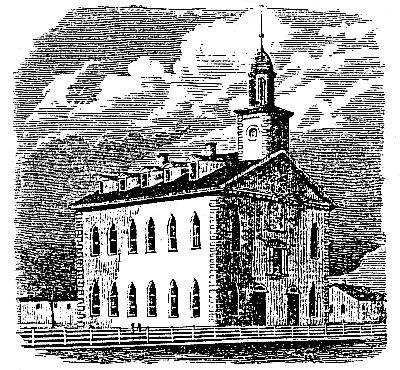OliverCowdery.com: The Premier Web-site for Early Mormon History

SOURCE MATERIALS FOR
CRISIS AT KIRTLAND
Mormons and anti-Mormons, 1831-39
Special Collections | Bookshelf | Mormon Classics | Newspapers | History Vault

|
Robert K. Fielding (1920-2006?) "Growth of the Mormon Church" (Bloomington: Indiana University, 1957) |
Pioneer Reminiscences, 1893 | Howe's Autobiography, 1878 | Pancoast's Thesis, 1929
Mr. Fielding's dissertation contains no formal copyright -- paraphrases
of part of his text are copyright © 1959 by the Utah Historical Society.
Only limited, "fair-use" selections of this dissertation are presented here.
|
THE GROWTH OF THE MORMON CHURCH AT KIRTLAND, OHIO A Dissertation submitted to The Faculty of the Graduate School In partial fulfillment of the requirements for the degree Doctor of Philosophy in the Department of History Indiana University by Robert Kent Fielding May 1957 |
Only limited, "fair-use" selections of this dissertation are presented here.
|
[ 1 ]
__________ 1 The official Mormon version of the origin of the Church will be found in Joseph Smith, History of the Church of Jesus Christ of Latter Day Saints... [ 2 ] The story of the origin of Mormonism that is accepted by the Church of Jesus Christ of Latter Day Saints, the official title of the largest group of the followers of Joseph Smith, was written in 1838 by the Mormon Prophet... (pages 2-11 not transcribed) 12 Although non-Mormon writers have universally doubted the Mormon story of the origin of the Book of Mormon, they have been unable to agree upon an acceptable alternative. 17 If Smith was a knave, an ignorant impostor, an amateur soothsayer, or even an intelligent deceiver, who wrote the book? Earliest writers ascribed it to Smith without question and labelled it as a work of crude eclecticism taken largely from the Bible and from current theological controversy, but it __________ ... 17 Kirkham, New Witness, gives the best documentation of efforts to prove the Book of Mormon man made. 13 was early suggested that Smith had collaborators. 18 The success of Mormonism in the Western Reserve and particularly among the followers of Sidney Rigdon, suggested Rigdon as a logical co-conspirator. In 1834, it was announced and well authenticated by contemporary testimony, that the book was taken largely from a romance written by one Solomon Spaulding whose work had somehow fallen into the hands of Smith. 19 This story, varied by including either Sidney Rigdon, or Parley P. Pratt, or Oliver Cowdery, as the guiding intelligence behind Smith's plagiarism, stood until the original manuscript written by Spaulding was discovered. It was at once obvious that although its similarity to the Book of Mormon might be suggestive, there was no correspondence in plot, names of characters, or essential details. 20 Since the failure of the Spaulding manuscript theory, there have been several other interesting suggestions each __________ 18 The earliest assertions of collaboration that this writer has discovered are reported in the Cleveland Herald in articles dated November 25, 1830, and again for September 15, 1831. The former suggests Oliver Cowdery, the latter "a man named Ringdon or Rangdon." 19 Brodie, No Man Knows My History Appendix B pp. 419-33, gives the best account of the Spaulding Manuscript acceptance of Rigdon as a possible author of the Book of Mormon. 20 Ibid. 14 following a unique line of reasoning and in many cases adding light to problems of early Mormon history by the thoroughness of their researches. One writer, Alexander Linn, accepted the early evidence as to the character of the Smith family and part of that which supported the now defunct Spaulding manuscript theory... (remainder of pages 14-41 not transcribed) 42 considered the phenomenon to signify the presence of the Holy Spirit and were astonished when Joseph pronounced it as evil and came forward, rebuked it as a foul spirit and commanded it to depart. 33 It is generally considered that the most spectacular miracle performed at Kirtland by the Mormon Prophet was the healing of the woman with the rhumatic arm. Mrs. John Johnson, of Hiram, Ohio, came with some friends to visit Joseph Smith at the Whitney home in Kirtland. In the course of the conversation the question of the power to heal was raised and someone called attention to Mrs. Johnson who, for some time had been unable to raise her hand to her head. Did anyone on earth have power to heal her? According to non-Mormon witnesses, Smith did not respond immediately, but later when the conversation had turned to other subjects, he arose and walking across the room, took Mrs. Johnson by the hand and said in the most impressive manner: "Woman, in the name of the Lord Jesus Christ, I command thee to be whole." He immediately left the room and those who remained were struck with awe both by what had been said and by seeing Mrs. Johnson lift her arm above her head with no evident pain. Next day she was able to do her washing unassisted and soon afterward joined the Church. 34 __________ 33 Ibid., p. 175. 34 Hayden, History of the Disciples, pp. 250-51. 43 These marvelpus manifestations of apparently supernatural power were one of the chief means of spreading the fame of Mormonism abroad. People flocked to Kirtland by thousands. 35 To the believers they were convincing signs of the truthfulness of the gospel as preached by the Mormons; to others they were exhibitions of the power of satan and indicative of the guileful craftiness and deliberate deception. 36 But false or true, 37 it was the desire for ... (remainder of text not transcribed) |
|
Robert K. Fielding's 1957 Thesis 
(under construction)
|
return to top of this page
OliverCowdery.com | Crisis at Kirtland (Preface) | Mormon Classics
last revised: Aug. 28, 2006